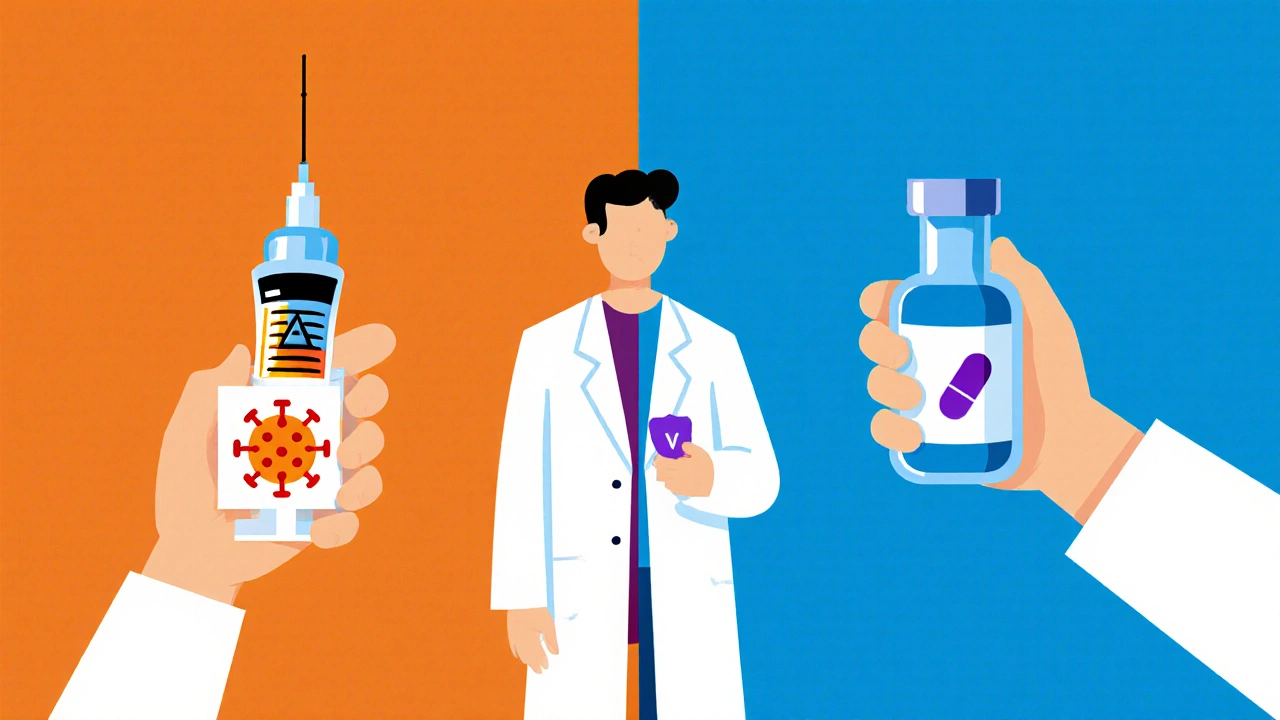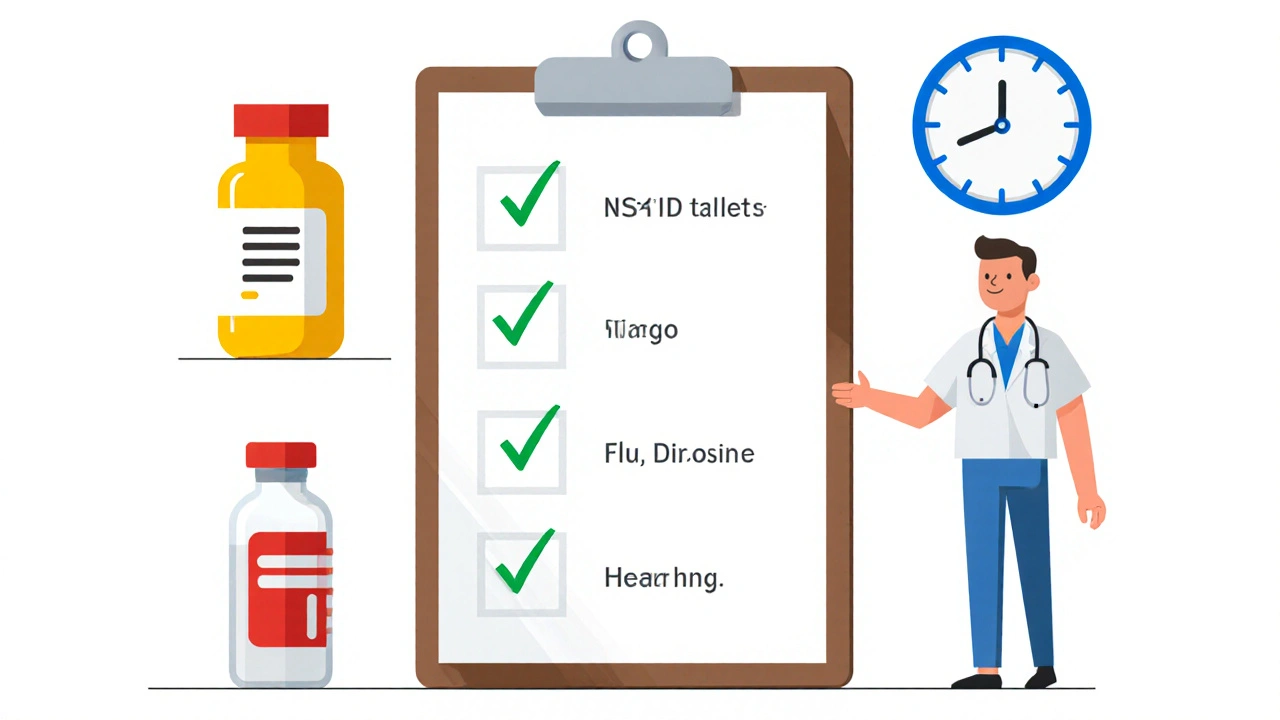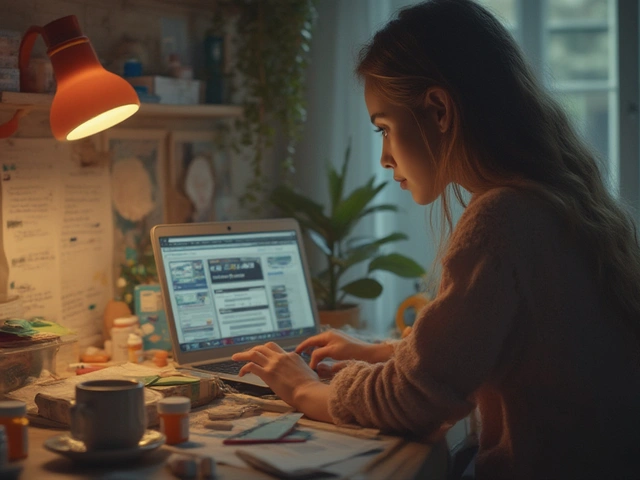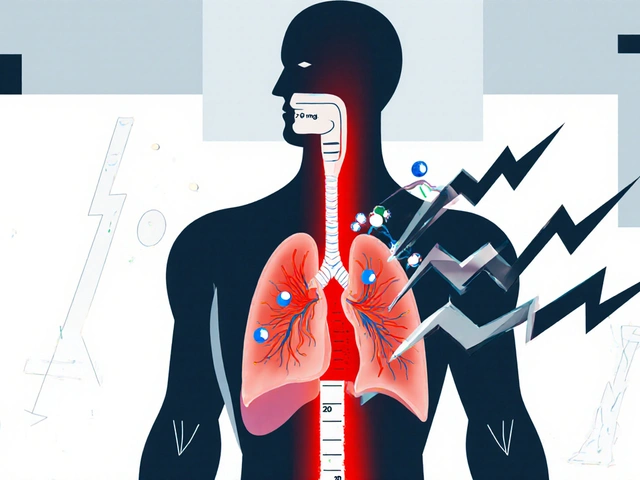Living with Ankylosing Spondylitis is a daily balancing act between pain, stiffness, and the need to stay active. Add vaccinations into the mix, and the equation can feel even more confusing. This guide walks you through what you need to know so you can protect yourself without compromising your treatment plan.
What Is Ankylosing Spondylitis?
Ankylosing Spondylitis (AS) is a chronic inflammatory disease that primarily attacks the spine and sacroiliac joints, eventually leading to fusion of the vertebrae. It belongs to the broader family of spondyloarthropathies and shows a strong genetic link to HLA‑B27. HLA‑B27 is a protein on the surface of white blood cells that, when present, increases the odds of developing AS by up to 80% in certain populations.
Typical symptoms include lower back pain that improves with movement, morning stiffness lasting more than an hour, and reduced chest expansion. Over time, the inflammation can cause new bone formation, making the spine rigid. Early diagnosis and a combination of medication, physiotherapy, and lifestyle changes can slow progression.
Vaccinations 101: Types and How They Work
Vaccinations are medical preparations that train the immune system to recognize and fight specific pathogens without causing disease. The main categories are:
- Live attenuated vaccines: contain a weakened form of the germ (e.g., measles, varicella). They provoke a strong, long‑lasting response but can be risky for people with weakened immunity.
- Inactivated vaccines: use killed germs or fragments (e.g., flu shot, hepatitis B). Safer for immunocompromised patients but often require boosters.
- Subunit, recombinant, and mRNA vaccines: deliver only parts of the pathogen (e.g., COVID‑19 mRNA vaccines). They are highly specific and have excellent safety profiles.
Understanding these categories is crucial because many AS patients are on immunosuppressive medication, which changes how they should approach each vaccine type.
Why Vaccination Matters for People with Ankylosing Spondylitis
Living with AS often means taking drugs that dampen the immune system, such as Biologic therapy. Biologics target specific inflammatory pathways, notably tumor necrosis factor (TNF) and interleukin‑17 (IL‑17), and are highly effective at controlling disease activity. While these medications improve quality of life, they also reduce the body’s ability to fight infections.
Respiratory infections, especially influenza and pneumococcal disease, are more common and can trigger flares of AS. A severe infection may also force a temporary halt of biologic treatment, risking a rebound of inflammation. Therefore, staying up‑to‑date with vaccines is a proactive way to safeguard both general health and the stability of your AS regimen.

Safety Concerns: Live vs. Inactivated Vaccines
The biggest safety question revolves around whether live vaccines are safe for patients on immunosuppressive drugs. Current guidelines suggest:
- Live vaccines (e.g., varicella, measles‑mumps‑rubella, yellow fever) should generally be avoided while on high‑dose biologics or systemic steroids. If a live vaccine is essential, a temporary medication pause-usually 2‑4 weeks before and after the shot-may be recommended.
- Inactivated vaccines (e.g., flu, COVID‑19, pneumococcal) are considered safe and are strongly encouraged. They can be administered without altering most AS medications.
Research published in the Arthritis & Rheumatology journal (2023) reviewed over 2,000 AS patients on TNF inhibitors and found no increase in serious adverse events after receiving inactivated vaccines. However, a small uptick in mild local reactions (redness, soreness) was noted, which is typical for any vaccine.
Vaccines Most Relevant to Ankylosing Spondylitis Patients
Below is a quick rundown of the vaccines you should discuss with your rheumatologist:
- Seasonal Influenza (Flu) Vaccine: Year‑ly inactivated shot. Reduces the risk of flu‑related arthritis flares.
- COVID‑19 Vaccine: mRNA or viral‑vector formulations are both safe. Booster doses are recommended according to national guidelines.
- Pneumococcal Vaccine: Two‑dose series (PCV13 followed by PPSV23) protects against bacterial pneumonia, a serious threat for immunocompromised adults.
- Hepatitis B Vaccine: Important for anyone receiving long‑term immunosuppressants, as liver infections can complicate medication metabolism.
- Shingles (Herpes Zoster) Vaccine: Recombinant subunit (Shingrix) is preferred over the live attenuated version for patients on biologics.
- Human Papillomavirus (HPV) Vaccine: Recommended up to age 45; protects against virus‑related cancers, which can be more aggressive in immunosuppressed individuals.
Live vaccines such as the traditional varicella or yellow fever shots are generally postponed or avoided unless travel or specific exposure makes them unavoidable.
Timing Vaccinations Around Your Medication
Coordinating vaccine timing with your AS treatment can maximise protection and minimise risks. Here’s a practical cheat‑sheet:
- NSAIDs (e.g., ibuprofen): No need to alter timing; they don’t affect immune response significantly.
- Conventional DMARDs (e.g., methotrexate): Aim to give inactivated vaccines at the start of a dosing cycle, when drug levels are at their lowest.
- TNF inhibitors (e.g., etanercept, adalimumab): Inactivated vaccines can be given at any point. For live vaccines, stop the drug 2-4 weeks before the shot and resume at least 2 weeks after, if disease activity permits.
- IL‑17 inhibitors (e.g., secukinumab): Same guidance as TNF blockers.
- Corticosteroids (≥10 mg prednisone daily): Consider reducing dose before live vaccines if possible; otherwise prefer inactivated options.
Always consult your rheumatologist before making any changes; abrupt medication stops can trigger disease flare‑ups.

Live vs Inactivated Vaccines - Quick Comparison
| Aspect | Live Vaccine | Inactivated Vaccine |
|---|---|---|
| Immunity Strength | Strong, long‑lasting | Good, often requires boosters |
| Safety with Immunosuppression | Potentially unsafe; may need medication pause | Generally safe; can be given anytime |
| Typical Examples | Varicella, MMR, Yellow Fever | Flu (inactivated), COVID‑19 mRNA, Pneumococcal |
| Side‑effect Profile | Mild viral symptoms; rare severe reactions | Local soreness, low‑grade fever; rare allergic reactions |
Practical Checklist Before Your Next Vaccine
- Make a list of all current AS medications (dose, frequency).
- Ask your rheumatologist if any medication adjustments are needed.
- Confirm whether the vaccine is live or inactivated.
- Schedule the appointment at a time when disease activity is stable.
- Bring a written record of past vaccinations and any allergic reactions.
- After the shot, monitor for unusual joint pain or fever lasting more than 48 hours and report to your doctor.
Following this checklist can help you avoid unnecessary delays and keep both your immune system and AS under control.
Frequently Asked Questions
Can I get the flu shot while on a TNF inhibitor?
Yes. The flu vaccine is inactivated and considered safe for patients taking TNF inhibitors. No medication pause is needed.
Should I avoid the shingles vaccine because I’m on biologics?
Choose the recombinant subunit vaccine (Shingrix). It’s non‑live and safe for biologic users. The older live shingles vaccine should be avoided.
What if I need a travel vaccine that’s live, like yellow fever?
Discuss a temporary hold of your biologic with your rheumatologist-usually 2-4 weeks before and after the shot. If stopping isn’t possible, weigh the travel risk versus disease flare risk.
Do vaccines trigger an AS flare?
Mild, short‑lived joint discomfort can occur, but large studies show no increase in serious flares after inactivated vaccines. If you notice worsening symptoms, contact your doctor.
How often should I get the pneumococcal vaccine?
Adults on immunosuppressive therapy get a 13‑valent PCV13 dose first, followed by a PPSV23 dose at least 8 weeks later. A booster of PPSV23 is recommended every 5 years.
Staying on top of your vaccine schedule doesn’t have to be a headache. By understanding the types of vaccines, coordinating with your medication plan, and keeping an open line with your rheumatologist, you can protect yourself against preventable illnesses and keep your ankylosing spondylitis as stable as possible. Remember, the goal is to stay healthy enough to enjoy life-and that starts with informed choices about vaccination.







Devendra Tripathi
October 21, 2025 AT 01:27Honestly, all this hype about vaccines being a must‑have for AS patients feels like a scare‑tactic pushed by pharma. You’re told to line up for shots like they’re the holy grail of disease control, but nobody mentions the unknowns. The guidelines ignore individual variability and pretend a one‑size‑fits‑all works for everyone. I’m not saying skip them altogether, but you deserve a real risk‑vs‑benefit conversation, not a blanket recommendation. Until the data are crystal clear, I’ll keep my meds steady and my vaccine schedule skeptical.
Vivian Annastasia
October 21, 2025 AT 23:53Wow, another checklist for the already overwhelmed AS crowd-because we totally have nothing better to juggle than pain, meds, and now a murder‑board of vaccine options. It’s adorable how the article pretends the “quick cheat‑sheet” will magically solve every infection nightmare. Sure, let’s trust that pharma‑sponsored studies didn’t sneak any hidden agendas, right? If you like being told exactly when to get poked, this will be your new favorite bedtime read.
John Price
October 22, 2025 AT 22:06Vaccines are fine, just follow your doc’s schedule.
Nick M
October 23, 2025 AT 20:20From a mechanistic perspective, the immunogenicity of inactivated platforms hinges on antigenic epitopic density, yet the covert collusion between biotech conglomerates and regulatory bodies skews post‑marketing surveillance data, obfuscating true adverse event incidence in immunomodulated cohorts. Moreover, the retroviral vector payloads used in some experimental COVID platforms raise non‑trivial concerns about off‑target integration in lymphoid niches of patients on TNF‑α blockers. In short, the safety veneer is statistically engineered, not empirically guaranteed.
eric smith
October 24, 2025 AT 18:33Let me break this down for you: live vaccines are absolutely contraindicated with high‑dose biologics because they can replicate enough to cause disease in a suppressed host, whereas inactivated vaccines pose no such risk and can be administered anytime. If you’re still unsure, just check the CDC’s VAX guidelines-who needs a rheumatologist’s opinion when the internet has a 3‑minute video? Also, remember that timing your flu shot around the trough of methotrexate levels maximizes seroconversion; it’s not rocket science.
Erika Thonn
October 25, 2025 AT 16:46i see ur point but think deeper you cant just tak a number and claim truth its more like a dancce of probabilities and hidden motives the mind is a mirror of the cosmos and the vaccines are but reflections i guess maybe we just need to trust the unknown and let the heart decideh
Ericka Suarez
October 26, 2025 AT 15:00Our great nation stands strong, and we will not let foreign pharma dictate our health decisions! The vaccine rollout is a test of patriotism-if you’re on biologics you must protect the country’s backbone, otherwise we all suffer. Remember, the flu is an enemy that attacks our families, so get that shot and keep America’s spine-both literal and metaphorical-standing tall!
Jake Hayes
October 27, 2025 AT 13:13The guidelines are clear: inactivated vaccines are safe for AS patients on TNF inhibitors; live vaccines require a drug holiday. Deviating from this protocol without consultation is clinically negligent.
parbat parbatzapada
October 28, 2025 AT 11:26Yo man the whole vacc thing is like a secret mission they dont tell u about the hidden side effects especially when you got those biologics in ur blood its like a ticking time bomb waiting to blow up if you get the wrong shot lol stay woke cant trust the system
Casey Cloud
October 29, 2025 AT 09:40First, make a list of every medication you are currently taking for ankylosing spondylitis and note the dosage and schedule. Second, check the specific vaccine you are planning to receive and verify whether it is live attenuated or inactivated. Third, if the vaccine is inactivated you can generally receive it without adjusting any of your biologic or DMARD therapy. Fourth, for live vaccines you should discuss a temporary pause with your rheumatologist and often the recommendation is to stop the biologic two to four weeks before the injection and wait another two weeks after. Fifth, keep a record of all past vaccinations and any adverse reactions you have experienced. Sixth, schedule your appointment when your disease activity is stable and you are not due for a dosage increase soon. Seventh, after the shot monitor your temperature and joint pain for at least 48 hours and report any unusual symptoms to your doctor. Eighth, remember that the flu shot and the COVID booster are high priority for immunosuppressed patients because respiratory infections can trigger flares. Ninth, the pneumococcal vaccine series (PCV13 followed by PPSV23) should be completed according to the recommended interval to protect against bacterial pneumonia. Tenth, the recombinant shingles vaccine Shingrix is safe for patients on biologics while the older live version should be avoided. Eleventh, hepatitis B vaccination is advisable especially if you are on long‑term immunosuppressants that affect liver metabolism. Twelfth, the HPV vaccine is recommended up to age 45 and adds protection against virus related cancers which can be more aggressive in immunocompromised individuals. Thirteenth, avoid live vaccines such as varicella or yellow fever unless travel requirements make them unavoidable and a drug holiday is feasible. Fourteenth, maintain regular communication with your healthcare team and keep them informed about any new symptoms after vaccination. Fifteenth, by following these steps you can maximize vaccine effectiveness while minimizing the risk of disease flare or infection complications.
Rachel Valderrama
October 30, 2025 AT 07:53Great, now we have a novel how‑to novel for the average patient-maybe we should start a reality show called “Vaccines and Vicious Spasms” because who doesn’t love a good checklist while dealing with chronic pain?
Brandy Eichberger
October 31, 2025 AT 06:06While the step‑by‑step approach is certainly thorough, I’d also suggest integrating a brief mindfulness session before each vaccination appointment; a calm mind can improve the overall experience and perhaps even enhance immunogenic response.
Eli Soler Caralt
November 1, 2025 AT 04:20i guess the universe throws us vaccines like riddles 🤔 the body’s immune orchestra plays a symphony each time we get a shot 🎶💉 maybe we just need to hum along and trust the melody 😊
Eryn Wells
November 2, 2025 AT 02:33Remember, every AS patient’s journey is unique, so feel free to share your own tips and experiences below 🌍💪-the more we support each other, the stronger our community becomes! 😊
Kathrynne Krause
November 3, 2025 AT 00:46Let’s turn this vaccine maze into a vibrant road trip-pack your meds, grab your appointment card, and cruise through the clinic with confidence, because staying protected is the ultimate power‑up for living boldly with ankylosing spondylitis!